A Guide to Bike Sharrows
West Allis just installed some. You find them all over. How do they differ from bike lanes and how should they be used?
There seems to be an explosion of sharrows, also called shared lane pavement markings, being installed in communities around Wisconsin since they were approved a few years ago by the Federal Highway Administration and now appear in the Manual of Uniform Traffic Control Devices, the bible for traffic engineers.
West Allis recently painted the bike and chevrons on 3.2 miles of streets. They were placed on S. 60th St., S. 76th St., S. 116th St., W. Greenfield Ave. and W. National Ave.
Up north, Wausau added a the shared lane markings to a number of streets in July, including Merrill Avenue (from Highway U to Union Avenue), Third Avenue (Union Avenue to Thomas Street), First Avenue (Union Avenue to Thomas Street), Bridge Street (Third Avenue to Sixth Street), Fifth Street (Bridge Street to Forest Street) and Sixth Street (Forest Street to Bridge Street).
As with any new traffic control device, there is going to be some initial confusion about what sharrows mean and how to use them. What exactly are sharrows and are they just a poor substitute for bike lanes? Here’s a guide to help you better understand them.
Lets begin with the standard traffic engineering guidance for parking lanes, bike lanes and motor vehicle travel lanes. Engineers can use their judgement and change these widths one way or the other by a foot or so, but standard widths are recommended:
- Parking Lane: 7-8ft, 8ft standard
- Bike Lane: 4ft (next to a curb) or 5-6ft next to parking, 5ft standard
- Motor vehicle travel lane: 10-12ft, 11ft standard
The image below illustrates a typical cross section for a 48ft wide street. I made this image on Streetmix.net, a cool interactive site that allows you to change the cross section of any street.
Sharrows are used when a road is an important bike connection but doesn’t have the width required to to add a bike lane. Among other benefits, shared lane markings reinforce the legitimacy of bicycle traffic on the street and can be used to suggest where bicyclists should ride, encouraging people to stay out of the door zone or even take the lane.
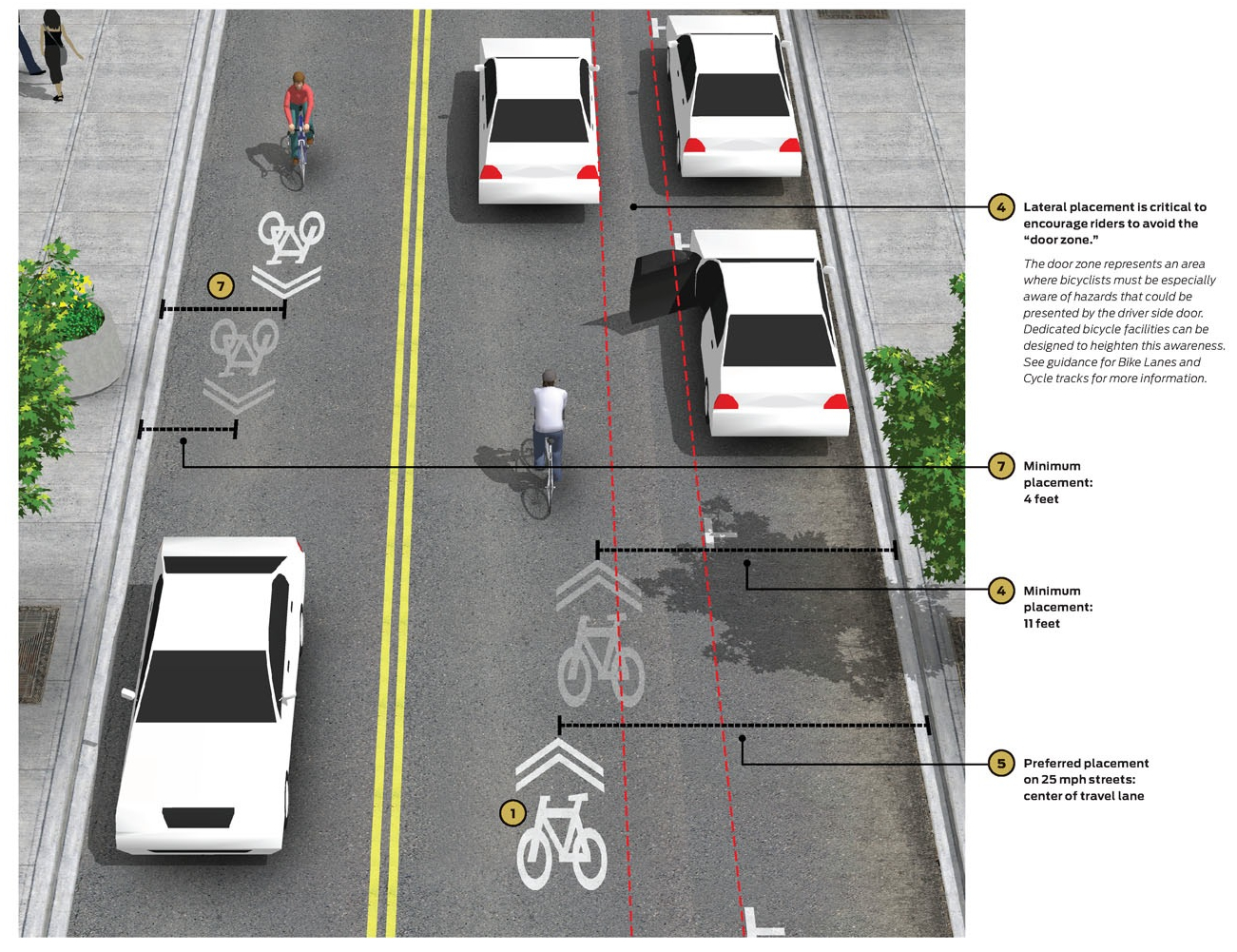
This image from the National Association of City Transportation Officials Guide (the New Testament for traffic engineers), illustrates both minimum and preferred placement options for shared lane pavement markings next to parking lanes and in curb lanes.
The bible (or at least the Old Testament) of traffic engineering is the Federal Manual of Uniform Traffic Control Devices. It offers the following standards and guidance on shared lane pavement markings:
- Assist bicyclists with lateral positioning in a shared lane with on-street parallel parking in order to reduce the chance of a bicyclist’s colliding with the open door of a parked vehicle;
- Assist bicyclists with lateral positioning in lanes that are too narrow for a motor vehicle and a bicycle to travel side by side within the same traffic lane;
- Alert road users of the lateral location bicyclists are likely to occupy within the traveled way;
- Encourage safe passing of bicyclists by motorists; and
- Reduce the incidence of wrong-way bicycling.
Guidance:
- Shared Lane Marking should not be placed on roadways that have a speed limit above 35 mph.
- Shared Lane Markings shall not be used on shoulders or in designated bicycle lanes.
- If used in a shared lane with on-street parallel parking, Shared Lane Markings should be placed so that the centers of the markings are at least 11 feet from the face of the curb, or from the edge of the pavement where there is no curb.
- If used on a street without on-street parking that has an outside travel lane that is less than 14 feet wide, the centers of the Shared Lane Markings should be at least 4 feet from the face of the curb, or from the edge of the pavement where there is no curb.
- If used, the Shared Lane Marking should be placed immediately after an intersection and spaced at intervals not greater than 250 feet thereafter.
- Option: Section 9B.06 describes a Bicycles May Use Full Lane sign that may be used in addition to or instead of the Shared Lane Marking to inform road users that bicyclists might occupy the travel lane.
So sharrows should not be used instead of bike lanes; rather they are used where bike lanes just won’t fit. They can also be used in mixing zones and through intersections to help guide bicycle traffic and remind people in motor vehicle traffic to look for bicycles. And just like any other poorly designed road, if you put sharrows in the wrong place, it can be worse than no bicycle markings at all.
This story was originally published by the Bicycle Federation of Wisconsin.
Bike Czar
-
Join a Bike Ride Under the Polish Moon
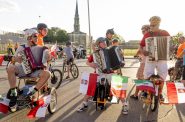 Jun 1st, 2018 by Dave Schlabowske
Jun 1st, 2018 by Dave Schlabowske
-
9 Reasons to Join National Bike Challenge
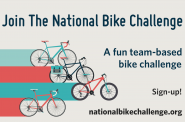 May 4th, 2018 by Dave Schlabowske
May 4th, 2018 by Dave Schlabowske
-
Biking Through the Mindoro Cut
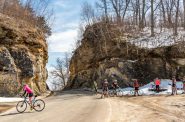 Apr 27th, 2018 by Dave Schlabowske
Apr 27th, 2018 by Dave Schlabowske


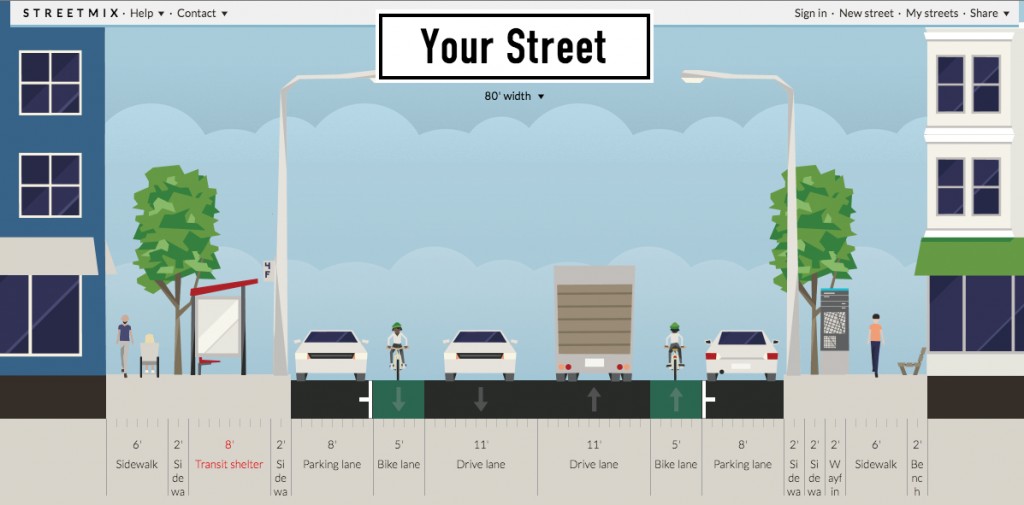


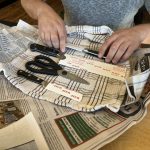
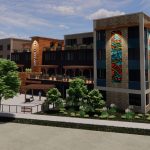


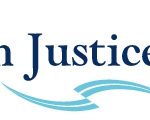


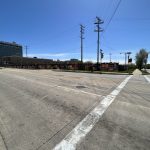
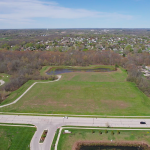




Some bad ideas. Why? Location of lanes on busy streets are invitations to die. I ride almost every day, have ridden to work for years, but not on those streets. I am bike racing coach, headed up Team West Allis for decades, most successful team in bike racing history in Wisconsin. My kids were all state champs in cycling. I have ridden over 50,000 miles in life.
These streets are death traps, get off those streets and do back streets. Have had three close friends killed. Too damn dangerous. Milwaukee is not set up for bikes except bike paths.
@WCD Please. Biking Milwaukee streets is easy and quite safe, and improvements like these only make it better.
Our teams cycled thousands of miles per summer, training and cannot tell you how many people have come close to nailing them, opened doors in front of them. If you pick your streets, stay off of the busy streets, wear bright clothes, have flashing strobes on heads and bikes you will be much safer. Every time someone hits someone I hear the same thing: “never saw them”. same with Harley’s.
Out in suburbs it is much safer with wider streets. east side is scarey.
@WCD I put a thousand to two thousand miles on the streets every year… No need for all the silly cloths.. And the point of sharrows is that takes you out of the dooring zoning. Quite frankly wider streets are worse to me as the speeds are higher.
I love cycling, am heading out now with my dog chasing and getting workout. We do that daily, on bike paths. The purposes of this sport are many. To get from one place to another and enjoy it, get workout, race, get to work.
Throughout world bikes are the thing, but many places like China, Holland old European cities, are built for the bike. Milwaukee is not, so to get somewhere, chart your course to get there safely make yourself visible. Have seen too many friends Get hit and the cyclist always loses. In this sport you might only get one big mistake. Bike paths down the middle of streets are suicidal.
Take your feckin’ bike and ride it one or two or three blocks over– wherever you need to, to be safe, and NOT on the busy thoroughfare. The death of common sense . . . and more government rules that are unnecessary were people simply to engage their brains, reinforce their sense of self-reliance and natural instinct for self-preservation, and not insist on their ABSOLUTE. RIGHT to do, or be, this or that on a space designed for vehicles weighing thousands of pounds.
@ Wisconsin Conservative Digest
I hope you and your dog had a good ride/run. I do the same thing with my two dogs (here on the streets of Milwaukee) and have for years. They are 12 now and won’t run as far, but when my Husky was younger, she would run the 7 miles from Washington Heights to my office on the East Side. My Border Collie is actually a better puller, but that is more the crazy work ethic she has than ability. It keeps their nails trimmed too!
Back to engineering and safety, the fact is that it is already very safe to ride in Milwaukee, but we can make it safer and more attractive to a wider percentage of people with thoughtful engineering as roads are reconstructed. Sharrows are one tool, but they need to be used correctly to work. They are pavement markings intended for low-speed road (they are not a path) and they give direction on positioning and alert drivers to expect bicycles. Brady Street is an ideal candidate for shared lane pavement markings.
And just to be clear, it is generally safer to ride in urban locations than suburban or rural areas if you are talking about the fatal crash rate. Despite the huge number of people who ride every year in Milwaukee, we typically have zero or one fatal crash. Most fatal crashes occur on higher speed roads, which are in the exurbs and rural areas.
@ Wisconsin Conservative Digest, What cycling team is this and who were your kids, the state champs? I’m not aware of any West Allis-based cycling team.
And be careful riding on those higher speed suburban and rural roads, it is not safer to ride there. It might be safer to ride in Chicago than Brookfield, WI. Pleasant and scenic does not mean it is safer. According to data found by Steve Vance of Grid Chicago, for every 1,000 people who commute to work by bicycle in Chicago in 2010, about 109 were involved in a crash. For the suburbs, other parts of Cook County and collar counties, the data breaks down like this:
Cook County, including Chicago: 116.12
Cook County, excluding Chicago: 132.73
Collar counties: 126.38
For every 1,000 people counted, the number of people involved in a crash in 2010 who either died or received an incapacitating injury breaks down like this:
Chicago: 10.68 people
Cook County, including Chicago: 11.92
Cook County, excluding Chicago: 15.27
Collar counties: 21.10
The same holds true for most urban vs suburban areas and Milwaukee is no exception. Nothing against riding in the suburbs, exurbs or rural areas, it is often much more pastoral. I rode across Grant County and probably only saw 5 cars the entire day. That can be super pleasant, but pleasant necessarily does not equal safer.
Our Team was Team West Allis from 1982 to 1994. We won almost 100 races in that time and 50 state championships. My son David Dohnal was 7th in Juniors nationally TT, Armstrong was first. He won over 25 state championships, was Cat. 1 and on national speedskating team. Daughter Darcie won several state championships, national team for speedskating, 17th in worlds and silver medalist in 1992 Olympics. Daughter Cai was two times nat. champ in speedskating won several on track. Tom Schuler, Heiden, Ochowicze’s Carpenters and many others are good friends.
It would be good fro everyone to study the efforts of Sheboygan to encourage cycling and what the Federal grant produced.
@WCD,
Thanks for the history, I found this interesting reference: http://johnkcoyle.com/2008/04/25/the-dohnal-family/. That was just before my limited time racing. With the Schneider sisters today, West Allis might have the highest number of champion racers of any Wisconsin city. Something they could add to their Wikipedia page 😉
I’ll ask Tom to share some stories with me on Monday when I see him in the office.
I think the Schneiders were customers of mine as was Tesch. have you counted LeBombard? Damuth, lots more.
I am a new resident to Wisconsin (Chicago transplant), and am wondering if the sharrows are really all that necessary. The guidance is one thing, but local/state laws likely matter more. Are cyclists allowed to take the entire lane even without markings?
People that follow these lanes on busy streets, take full lanes and act without fearing for their life when cycling in these areas, wear helmets, bright clothes, strobe lights are risking their lives.
@Ryan W,
Welcome to the land north of the Cheddar Curtain! Yes, it is legal for bicycles to take the full lane when there is not room for a car to pass without crossing the centerline. Brady Street is a great example of that kind of street where you should take the full lane. You are required to ride three feet away from cars to avoid the door zone, and cars are required to give you three feet when passing (thanks to a law we got passed), so there is not room for a car to pass in the same shared 11ft travel lane. I hope you will join the Bike Fed and come on our Polish Moon Ride, Aug. 22nd!
@WCD, we risk our lives every time we get out of bed, but we move through most days without fear of that death lurks around every corner. You have a right to your opinion, but not the facts. I don’t mean to be rude, and I am sure you an expert at racing and know a lot about training and riding in a peloton, but you clearly know little or nothing about bicycle safety when riding for transportation. At the very least, reference some traffic safety study when you comment, but better yet, stick to your area of expertise and I will stick to mine.
People that ride like that are idiots. Cap times last month had several studies about bike deaths, where they occur, Sheboygan just finished fed study. Fatalities overwhelmingly occur on trunk hiways, busy streets. Ask Jeff Littman’s and his girl friends relatives , Borgwardts, Cohens and the relatives of other fatalities. There are studies all over the places. to ride in those areas with people on phones, texting, on pot, drinking, is nuts, but go ahead. The rest of you use your heads. got to less busy streets, wear bright clothes, strobe lights if possible, no radios in ears and assume every car is about to hit you. I rode my motorcycle defensively for 40 years as my bike. No accidents with cars, several with gravel and curbs. Probably 70,000 on bike and same on cycles.
Shared lane pavement markings are not to be used on rural highways, that is in the guidance. Your comment has nothing to do with the blog post. None of the crashes you mention have anything to do with this blog post, in fact they make the point I made: fatal crashes are more likely to happen on rural or exurban roads than urban roads. Yes, ride defensively just as you drive defensively. Yes, motorcycles have the similar crash types, but a much higher fatal crash rate than bicycles. Sure, ride on less busy streets if you prefer them, but they are not by their nature safer nor do they get you where you want to go if your destination is on a busy street. Again, I am trying to politely ask that you keep your comments to what you know about, link to a specific study we can all review or just share your opinion based on your anecdotal experience.
Dave you are completely nuts and one of the reasons I quit running Wheelin Weekend, dealing with nuts. Not worth the time to discuss.
Cyclists:
A recent study by the Feds in sheboygan where it is much easier to ride cause of the smaller town and less traffic show that all of these stimuli, lanes etc did little to improve cycling, increase riders or improve safety.
A Cap times article shows that the busy streets in Urban areas, usually the county, state and federal hiways were the most dangerous, were to be avoided, and had the most fatalities, almost 60%. There tons of studies, read them. Collisions from the rear killed the riders and the drivers always said the same things: “Never saw them”. With the size of vehicles, texting, cell phones, speed etc. it is best o stay away from the busy streets. Map your route for safety first. Wear helmets, glasses, bright clothes like those worn by construction workers, reflective and strobe lights on bike front, rear and helmet if you are going to ride the dangerous streets. Cycling ,you might only get one accident and to listen to these people that want to send you into dangerous situations, even though you have the right of way, collisions with cars always lose.
@WCD Funny the Cap Times article I found starts like this: “In the 52 months from June 2008 to September 2012, Madison did not report a fatality from a crash involving a bicyclist and a motor vehicle.” It does point out the worst spots in Madison, but makes no comparison to rural roads at all.
Read more: http://host.madison.com/news/local/city-life/where-are-madison-s-most-dangerous-places-for-bike-car/article_4b381884-1a63-11e3-998e-001a4bcf887a.html#ixzz39T26Lri1
@WCD I haven’t spent time on the Sheboygan study, but there are numerous examples from cities all over the country (if not world) which have shown that infrastructure increases ridership. NOTE check out the trip numbers in Portland, despite its rainy weather and hilly geography.
Now to get to big ridership numbers I believe we need cycletracks as part of the equation like the ones in European cities with very high ridership numbers.
I love cycling, just got back from working on my new Prologue, tricky damn thing. I had five kids plus my wife and I racing, training almost every day. WE had two teams with several national champions, one Junior World champion in Moscow and one Olympic silver medalist. We trained for thousands of miles every day. Team West Allis had over 50 rider, Brookfield cycling 15, juniors. We had weekly meetings, number one was safety. Dumb kids believed that if they had the right of way, that somehow they were armored. After several car doors and one broken arm, some close calls everyone listened. Our jerseys were bright yellow or pink for women’s team, we did not ride at night, found all the back roads, read all of the memos from USCF and everyone’s experiences. never had one car collision. I have lost 4 friends the last 20 years, do not want to lose anymore. safety first. We need more bike paths. I ride them every day and they are well used by everyone. Safety first.
And one more thing… After 8.75 million trips (14.7 million miles) traveled on New York City streets (yes on New York’s busy scary streets) there have been 0 deaths and just 100 crashes (25 of note). All by a whole lot of people likely not wearing spandex, bright cloths, or helmets.
Where do these stats come from? Citibike: http://www.slate.com/blogs/future_tense/2014/05/30/nyc_citi_bike_zero_fatalities_in_new_york_city_bike_share_program_s_first.html
What you are stupidly saying is that everyone should disregard all smart safety things and disregard the fact that my daughter, Olympic silver Medalist, state champion cyclist, Dr Darcie Dohnal Sharapova, who has worked in many emergency rooms will tell you that cycling injuries are the most common injury treated. Boy some of you people are dumb asses. Maybe it’s the Pot.
Born and raidsed in MKE and now living in Seattle. I’m sad to see my hometown evidently succumbing to the bike nazis.
I rode my bicycle all over Milwaukee when I was a kid. Never had any problems. If you were on a bike, you stayed to the right. You used hand signals. If you rode at night, you had a light in the front, a light in back, and bright clothes.
Fast forward a few decades. Seattle has stuck “sharrows” all over the roads. They convey no information. They are essentially a political device to tell drivers that bicyclists have the upper hand now. Which, along with the narrowing of streets to create bike lanes, has caused rising anger at the bicyclists.
The bicyclists think they’re improving their lot with these things, and for a while they do. Then the backlash sets in, and (as in Seattle) bicyclists find themselves subject to a rising level of random violence and harassment. I know you won’t listen, because the bicycle activists consider themselves better than everyone else, and therefore talk to themselves. Oh well, you’ll learn.
p.s.: Don’t think you’ll solve anything with harsher law enforcement against motorists. Around here, the police despise bicyclists. Why? Because so many of them ignore the basic rules of the road, and are generally self-entitled brats. If you want to look at a group of people who have really cooked their own goose, come to Seattle, a city that once kinda sorta embraced the bicyclists but grows more hostile to them every year.
@Charlie, Thanks for another comment completely lacking in facts. It gives me another opportunity to share facts. According to a 2013 poll by the reputable research firm FM3, which has a margin of error of 4.9 percent, these are the facts about Seattle residents feeling toward bicycles:
73 percent of the 400 Seattle voters surveyed supported the idea of building protected bike lanes.
59 percent go further and support “replacing roads and some on-street parking to make protected bicycle lanes.”
79 percent have favorable feelings about cyclists.
Only 31 percent agree with the idea that Seattle is “waging a war on cars.”
As for bicycle advocates thinking we are better than other people (everyone? everyone who doesn’t ride a bike?), if you read anything I write, you will note I repeatedly make the argument people are people and it is unreasonable to expect them to behave any differently if they are on foot, on a bicycle or in a car.
@WCD, Since we teach cycling safety, and we are all insured, licensed safety instructors, no, I am not saying people should ignore “smart safety things.” As for your daughter, I assume you are misquoting her since a quick look at emergency room statistics is all it takes to prove you are wrong again. I am sure given her degree, she would make a more factual statement.
I have just as many cycling friends who are conservative as I do who are liberal, and no wonder, bicycling is the ultimate conservative transportation: cheap, safe, quick, self-reliant, no need to go to war for it, etc. Given the bikepartisan nature of cycling and your impressive racing heritage, I wish we could have had a different dialogue, but it seems you just want to fight, and I don’t have time for that. I have tried to respond politely with facts, while you have frequently been rude and stalwart in your refusal to respond with anything but anecdotal opinion. I have also noticed you have plenty of time to comment on virtually every blog post published here and probably elsewhere in the Wisconsin blogosphere. I feel I have exhausted any opportunity to use your comments to provide useful, relevant information to other readers, so this will be my final reply on this topic.
@WCD Nope nobody is saying that…
@Dave, I live in Seattle, remember? The last mayor, known as “Mayor McSchwinn,” was bounced out of office after one term. His predecessor lasted one term. Both were known for their bicycle advocacy. The current mayor is trying to continue it, but it running into significant resistance. None of these things happens overnight, but it’s happening here. Bicyclists have a low and declining reputation here.
Now, having grown up in Milwaukee, I know all about how it works in my beloved home town, how the trends on the coasts hit five to 10 years late. At the moment, bicyclists there are on the upswing. They’ll continue that way for a while, with the usual lag. And then the backlash will hit, after it has started here.
It’s so predictable, including your resistance. But it’s going to happen. Put my prediction in an envelope and open it in 10 years. You will see.
@Charlie, You live in Seattle, and have a right to your opinion, but not the facts. Here are the facts and the first thing mentioned on the platform that got your new mayor elected:
As Mayor, Ed will:
Create the Move Seattle Strategy; a prioritized comprehensive transportation strategy for Seattle that integrates and prioritizes our bike, pedestrian, transit and freight plans; staying true to the goals of each plan while recognizing transportation must work as a system linked to land use. Ed’s strategy will prioritize our investments and match priorities to funding opportunities so we don’t just plan work but actually secure funding, deliver projects and improve our transportation system.
So, I will stick to my scientific studies, ever-growing bike counts and even cite the election you brought up as a pro-bike referendum and put your prediction where it belongs. I look forward to hearing from you again in 10 years. Until then, I visit Seattle often, so keep an eye out for a middle-age blond guy with a south side Milwaukee accent in Packers or Bike Fed gear walking, on a bike or on transit.